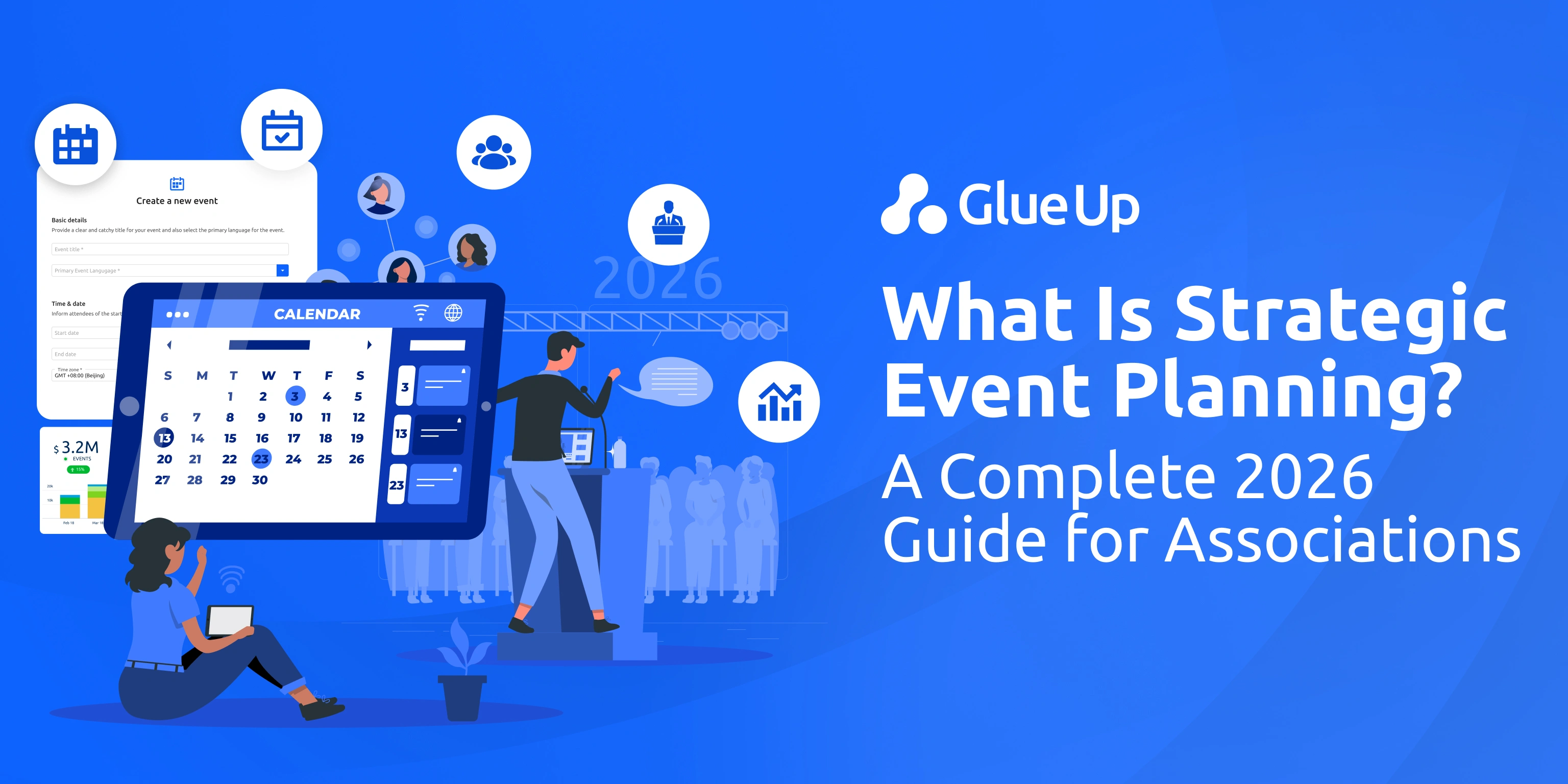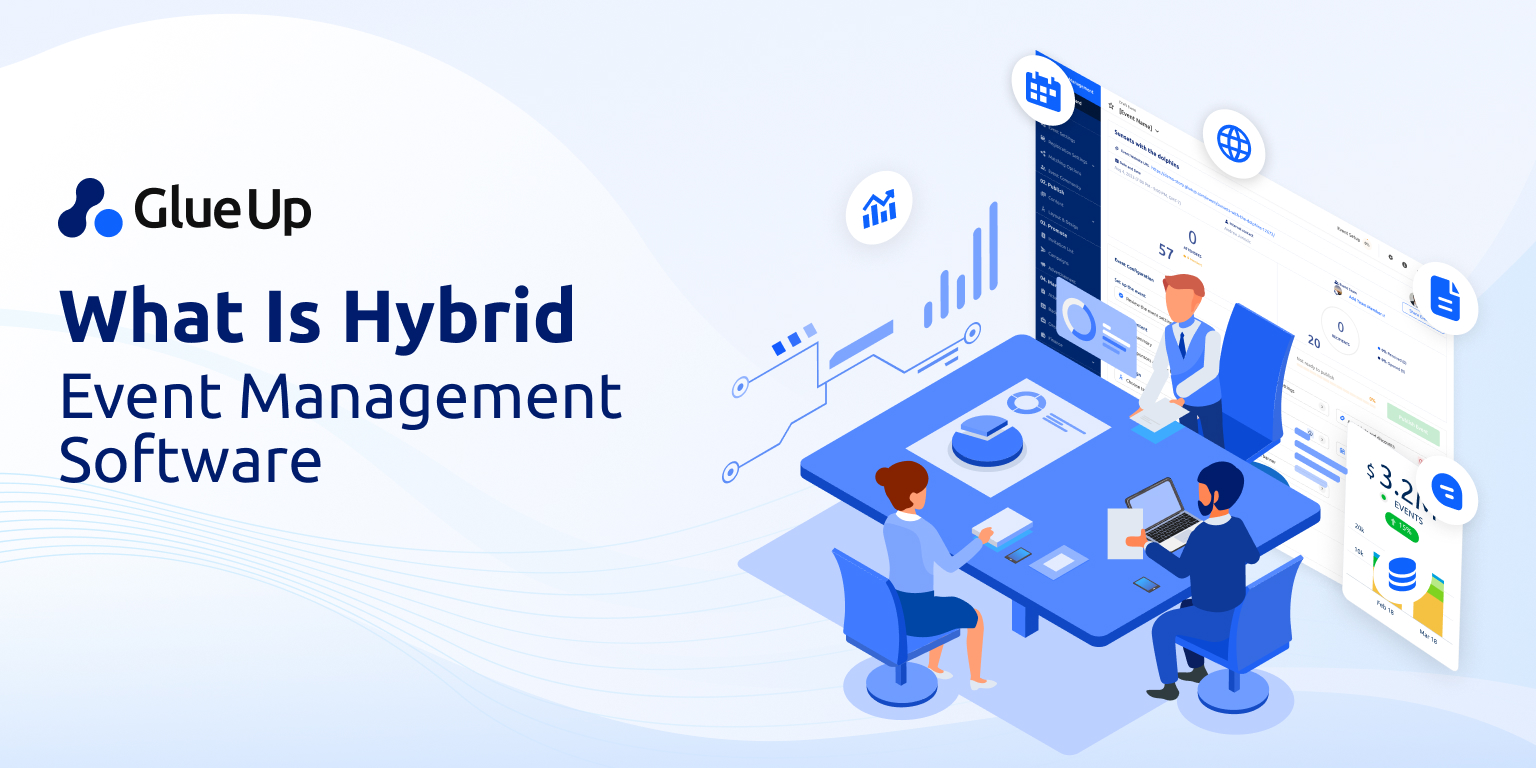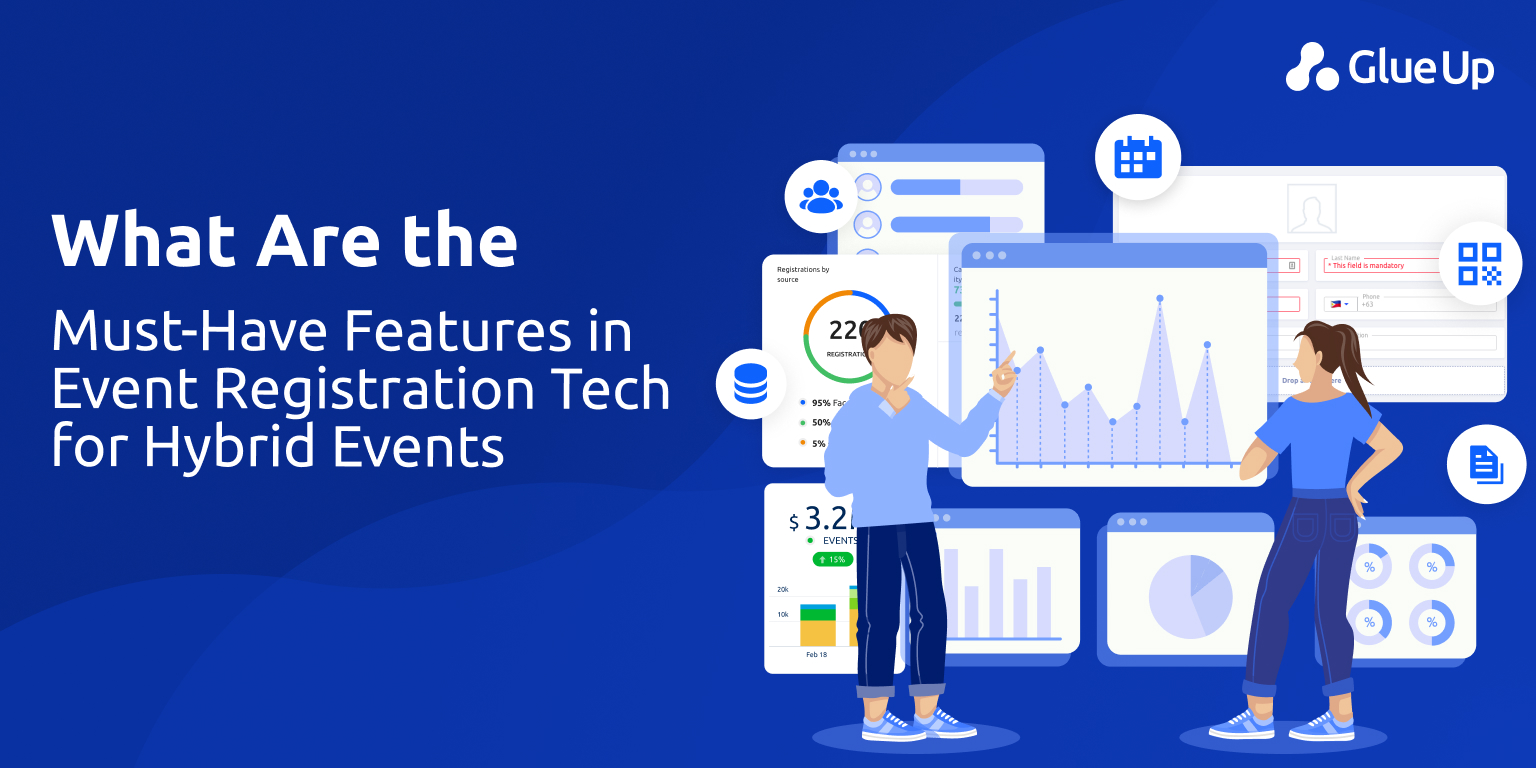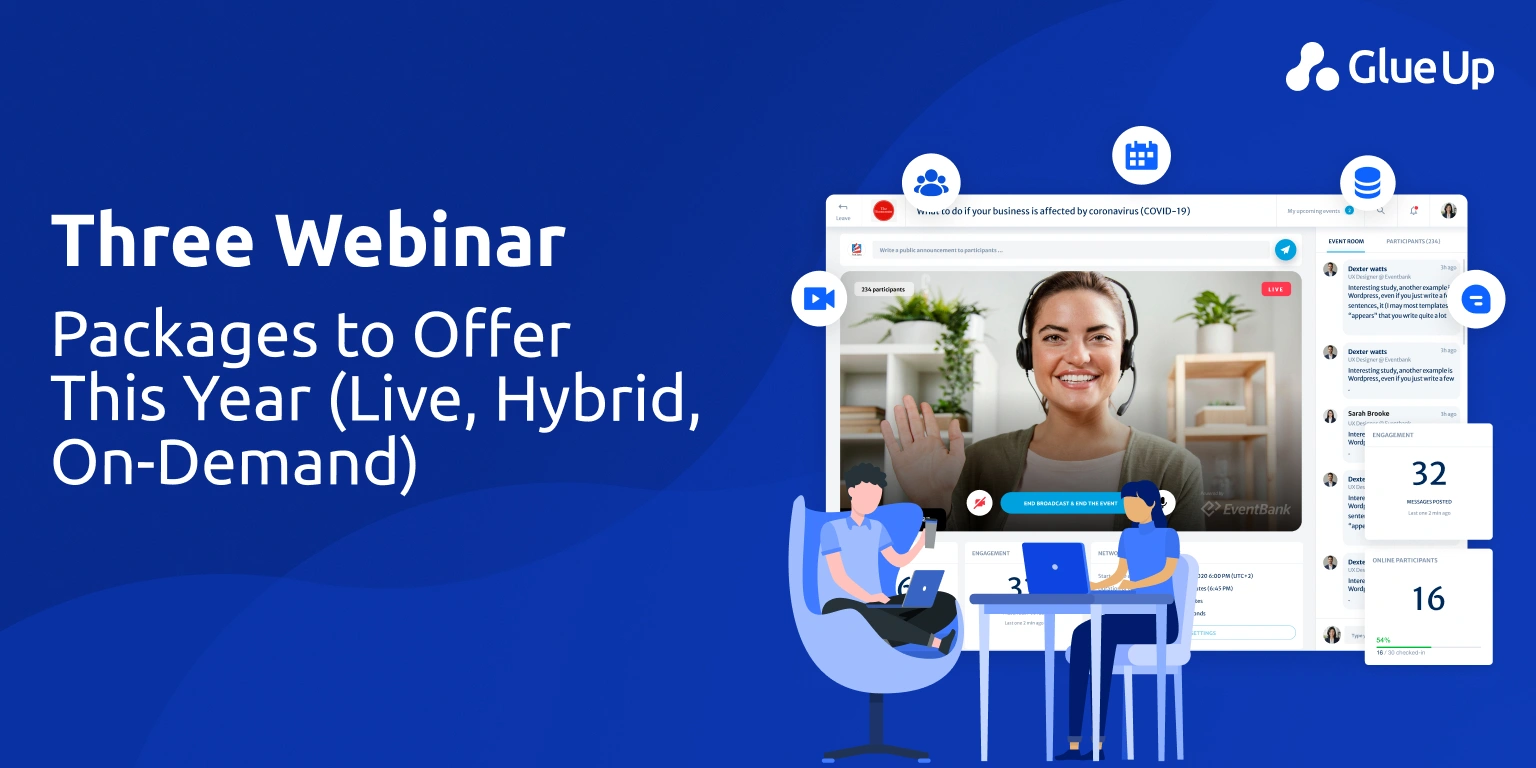
Strategic event planning has become the differentiator between organizations that grow and those that stall. In 2025, 82% of associations identified events as their top revenue driver according to Cvent’s Event Trends Report, yet profitability fell across much of the membership sector. Rising costs, volatile attendance, and declining sponsor engagement made one truth inescapable: logistics alone no longer guarantee success.
In 2026, associations that continue to plan events in isolation will keep chasing outcomes. In contrast, those that embrace data-driven, strategic event planning will design programs that tie every decision (budget, format, audience, platform, etc.) to measurable ROI and sustained member value.
This quick guide unpacks what it means to plan with strategy at the center, why the coming year represents a crucial moment for event-driven revenue, and how forward-thinking associations building a sustainable association revenue engine to connect engagement, forecasting, and financial performance in one loop.
For a more detailed overview, feel free to get in touch with our team by booking a demo. Here’s an overview of our all-in-one AI-powered association management software:
Key Takeaways
- Strategic event planning is now an executive function. It aligns programming, data, and finance to achieve measurable ROI across engagement and revenue.
- Integration defines efficiency. Linking event software with CRM, finance, and marketing systems ensures visibility and accountability at every stage.
- Data informs strategy. Predictive analytics and real-time dashboards allow associations to plan proactively instead of reacting post-event.
- Sponsorships thrive on transparency. Sponsors renew when you can demonstrate quantifiable exposure and audience impact.
- Glue Up transforms process into progress. Its unified event management platform helps associations plan, execute, and analyze from one intelligent system.
What Strategic Event Planning Means For Modern Associations
True strategic event planning goes far beyond logistics. It’s about designing events that advance your organization’s long-term objectives, whether building engagement, revenue, or reputation in measurable ways. With the stakes so high, every decision, from speaker selection to post-event analytics, must link directly to positive outcomes that strengthen member value and financial sustainability.
From Coordination to Strategic Alignment
Events like annual galas, conferences, and professional training workshops aren’t stand-alone projects; they’re extensions of your association’s mission. A strategic event planning framework connects program design, marketing, and sponsorship around unified goals. For example, an annual conference should should drive retention, highlight thought leadership, and create pathways for new partnerships.
Strategic alignment also means knowing what not to do. Associations that try to replicate last year’s formula often overlook emerging needs or underinvest in experiences that could deliver greater ROI. So, as a strategic planner, you must adopt processes and systems that allow you to use real-time data to pivot, refine, and allocate resources where they’ll create the most impact.
Integrating Data and Decision-Making
Member data has become the compass of modern association event management. According to Cvent’s guide to event success, leading organizations now rely on advanced event analytics software to forecast attendance based on historical data, track engagement patterns, and calculate ROI across their event portfolios.
Data integration is especially vital when membership, finance, and marketing share accountability for event outcomes. A unified platform such as Glue Up’s event management software enables you to connect registration data, email campaigns, and post-event feedback into one dashboard. This level of integration turns fragmented reporting into strategic intelligence.
Aligning Sponsorship and Value Creation
Sponsors have become more selective, and with good reason. They want measurable exposure and engagement metrics, not just logo placement. Strategic planners now treat sponsorship as a partnership that delivers mutual ROI.
As outlined by Strauss Event Strategy, associations that involve sponsors early in the planning process by aligning packages with audience insights and program themes see higher retention and greater renewal rates. Glue Up’s integrated association CRM and event automation tools make that possible by tracking sponsor interactions, reporting engagement outcomes, and streamlining follow-up after each event.
Designing for Long-Term Engagement
The true measure of success isn’t event attendance; it’s what happens afterward. Strategic planners use post-event data to nurture connections, convert participants into members, and re-engage them across other programs throughout the year.
With Glue Up’s member engagement tools, you can design follow-up campaigns that personalize outreach based on attendee behavior and interest. This transforms one-time participation into an ongoing relationship, ensuring events feed directly into the organization’s broader engagement strategy.
Key Components of a Strategic Event Plan for 2026
Strategic event planning isn’t a checklist anymore, although, we have one of those, too, ready to download. It’s a coordinated ecosystem of people, processes, and platforms working toward shared outcomes. For associations preparing for 2026, the focus is shifting from execution to orchestration, which involves aligning every event decision with measurable goals, predictable revenue, and member impact.
Below are the key components every association must integrate into its strategic event planning process, each built around clarity, collaboration, and data-driven accountability.
Define Purpose and Outcomes Early
Every successful event begins with a clear understanding of why it exists. Before budgets are drawn or venues are booked, leadership should articulate measurable outcomes tied to both engagement and revenue.
Set objectives across four categories:
- Financial: Define sponsorship targets, ticket goals, and expected ROI.
- Engagement: Establish metrics around attendance, satisfaction, and participation.
- Brand: Identify what narratives or positioning the event should reinforce.
- Retention: Link programming and communications to post-event member renewals.
A strategic association event plan should include KPIs for each of these areas. Once defined, these metrics guide all subsequent planning, ensuring alignment between departments and accountability across teams.
Build a Cross-Functional Event Team
Events that generate measurable results aren’t managed in isolation—they’re built by collaborative teams that represent every part of the association.
A well-structured team should include:
- Event Director: Oversees strategic direction, budgeting, and partner alignment.
- Marketing Lead: Drives communication, branding, and audience acquisition.
- Sponsorship Manager: Develops packages, manages relationships, and tracks fulfillment.
- Finance Officer: Handles forecasting, cost tracking, and reconciliation.
- Data Analyst or CRM Manager: Monitors engagement analytics and ROI.
This structure ensures every stakeholder, from communications to finance, contributes to both event execution and measurable performance.
Our event platform centralizes these efforts by connecting communication, registration, and financial data in one workspace, creating a shared operational view that eliminates the silos that often slow progress.
Develop a Dynamic Event Budget
A static budget is a liability in 2026. Costs fluctuate rapidly, especially for venues, vendors, and hybrid technology. Your association event budgeting strategy must remain flexible and data-informed.
Steps to strengthen financial planning:
- Set a Baseline Forecast: Estimate revenue and expenses across categories like sponsorship, registration, and marketing.
- Create Variance Scenarios: Model conservative, moderate, and aggressive forecasts to understand potential risk.
- Integrate Finance and CRM Data: Use Glue Up’s finance and invoicing tools to sync income streams with expense reports for real-time visibility.
- Review Monthly: Finance and event leads should meet monthly to review deviations and reallocate funds dynamically.
Ideally, you should integrate financial data directly into event analytics dashboards, helping leadership evaluate performance before, during, and after each event.
Establish a Data and Technology Framework
Data drives every modern event. A strategic event planning system should consolidate analytics across registrations, sponsorships, and engagement.
Key data priorities include:
- Centralized Registration and Attendance Data for real-time insight into who attends and why.
- AI-Driven Event Forecasting to predict attendance and engagement using historical trends.
- Post-Event Reporting Dashboards to evaluate content, speakers, and audience retention.
- CRM Integration to connect event data with membership and sponsorship pipelines.
- Integration with third-party software to enable more capabilities to improve operations or engagement.
Design the Attendee Experience Around Engagement
One of the most crucial aspects of strategic event planning is building a sustainable experience architecture. Associations should design every stage of the attendee journey to build connection and deliver tangible value.
Steps to elevate the attendee experience:
- Map the Journey: From first registration email to post-event survey, define every touchpoint.
- Segment Communications: Use event marketing automation to deliver personalized updates based on membership type, interests, or past participation.
- Enable Digital Engagement: Use event apps or hybrid tools for live Q&A, polls, and networking.
- Gather Feedback: Distribute post-event surveys within 24 hours while the experience is fresh.
InEvent notes that personalization and digital participation tools have become core predictors of post-event satisfaction and return attendance.
Create a Sponsorship and Partner Strategy
Sponsorships are often the difference between breakeven and profitability. Strategic planning means treating sponsors as collaborators, not transactions.
To strengthen sponsorship outcomes:
- Use Audience Insights: Leverage CRM data to match sponsor goals with attendee interests.
- Offer Tiered Packages: Build value-driven tiers based on visibility and engagement opportunities.
- Automate Delivery: Use Glue Up’s CRM integration to manage deliverables, reminders, and sponsor communications.
- Report ROI Transparently: Provide sponsors with post-event reports showing leads, impressions, and conversions.
This transparency builds trust and increases renewal rates, transforming sponsorships into long-term partnerships.
Close the Loop with Post-Event Analysis
The most overlooked step in event strategy is post-event evaluation. This is where insights become action.
Your post-event process should include:
- ROI Reporting: Compare revenue and engagement metrics against objectives.
- Cross-Department Review: Finance, marketing, and membership teams should analyze data together.
- Action Planning: Turn key learnings into next-year improvements.
Glue Up’s event analytics and CRM integration make this process easier, allowing you to generate post-event reports quickly and share it across departments to align on future strategy.
Strategic event planning is the new operational discipline of high-performing association looking to build scalable systems, accountable teams, and data intelligence that extend far beyond the conference room.
From Planning Events to Engineering Outcomes
By 2026, event planning will no longer be judged by attendance or logistics. It will be measured by alignment, agility, and measurable contribution to growth. The associations that succeed will be those that treat every event as an investment vehicle for engagement, retention, and sponsorship ROI.
Strategic event planning isn’t about adding more layers of process; it’s about creating precision. It connects teams through shared data, integrates insights with decision-making, and builds momentum that extends beyond a single conference or summit.
Glue Up gives you the structure to do exactly that, turning events from line items into leadership tools. It’s where planning meets strategy, and where strategy becomes performance.
Ready to plan smarter for 2026? Book a demo and see how Glue Up’s event management platform helps you turn every event into a measurable growth driver.
Frequently Asked Questions
What makes strategic event planning different from traditional event management?
Traditional planning focuses on logistics—venue, speakers, and schedules. Strategic event planning aligns every decision with broader organizational goals such as member retention, sponsorship ROI, and engagement analytics.
How can associations use data to improve event performance?
Associations can track attendance, engagement, and conversion metrics through integrated dashboards. Platforms like Glue Up consolidate this data in real time, helping leaders adjust strategies and forecast revenue more accurately.
How does Glue Up’s event management software support strategic planning?
Glue Up connects registration, finance, CRM, and communication modules in one ecosystem. This integration eliminates manual data handling and gives leaders a unified view of engagement, ROI, and member participation.
Can Glue Up help with hybrid and virtual events?
Yes. Glue Up supports hybrid and virtual formats with event apps, live streaming, and real-time engagement tools, allowing associations to extend reach and measure performance consistently across channels.
What KPIs should associations track for strategic event success?
Track metrics tied to ROI and engagement: sponsorship renewals, registration growth, session participation, post-event satisfaction scores, and year-over-year revenue contribution.
Quick Reads
- How to Build a Revenue Engine with Association Management Software
- Add-On Cart for Member Retention & Growth
- Simplify Multi-Currency Payment Posting for Community Chapters With Glue Up + Paygage
- AI Automation for Event Registration & Beyond
- Integrating AI into CRM for Membership Growth
- How to Build a Chapter Event Calendar
- What Is All-In-One Association Software?
- AI-Powered Member Check-In Software



